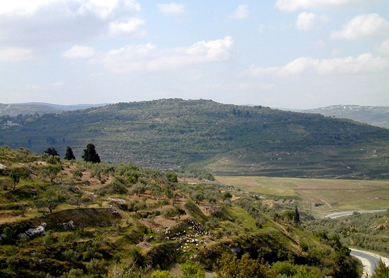The Black Obelisk in the British Museum, originally discovered in the ancient Assyrian capital of Nimrud, features a series of beautifully carved figures of animals and plants on its four panels. The Assyrian ruler Shalmaneser III (858–824 B.C.E.), who led a number of military campaigns to Syria-Palestine, erected this obelisk. More striking than the finely carved flora and fauna is a scene of two vassals prostrating themselves before Shalmaneser. Who are they and what do they signify?
From the cuneiform caption, which reads “Jehu, son of Humri [Omri],” the prostrated figure in the second register is generally regarded as Jehu of Israel, who brought or sent tribute to Shalmaneser in 841 B.C.E. Ever since Edward Hincks identified this person with biblical Jehu (
According to the Bible (
Another extrabiblical source may provide a clue: the Mesha Stela, erected by Mesha, king of Moab, also refers to Omri and his son, who oppressed Moab in the ninth century B.C.E.
These references to Omri in extrabiblical sources seem to indicate that the northern kingdom of Israel emerged as a major regional power in Syria-Palestine under Omri, perpetuating his name in Assyria, and eventually house of Omri became synonymous with the northern kingdom of Israel in Assyrian royal inscriptions, even when Israel’s kings no longer came from his lineage.
Assyrian royal ideology also shows a conspicuous tendency to magnify the deeds of kings. Referring to a dynasty by its founder is customary in Assyrian royal inscriptions. However, Assyrian royal inscriptions continued to designate the northern kingdom of Israel as bīt Humri, “house of Omri,” through the eighth century B.C.E, long after Jehu’s annihilation of Omri’s dynasty in 841 B.C.E.
In addition, Ahab, Omri’s actual son, was counted as one of the major members in the anti-Assyrian coalition that Shalmaneser confronted in northern Syria in 853 B.C.E. After twelve years, Shalmaneser finally subjugated the northern kingdom of Israel. Even if it was Ahab, the previous Omride king of Israel who successfully fought back the Assyrians, it is Jehu the usurper who is immortalized on the Black Obelisk. Jehu, “son of Omri” becomes a symbol of Shalmaneser’s dominance and the ultimate fall of his long-time enemy, Israel.
To complicate matters, the Bible also calls Omri’s dynasty “house of Ahab.” Most of the biblical description of Ahab depicts him as a bad king (




